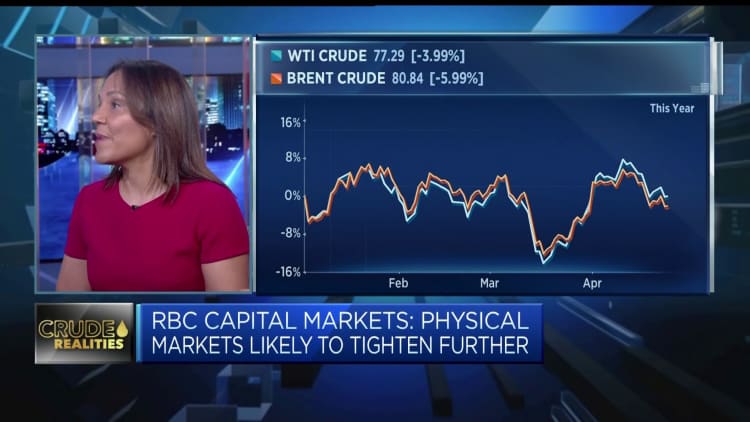[ad_1]
OPEC Secretary General Haitham Al Ghais said finger-pointing and misrepresenting the actions of OPEC and OPEC+ was “counterproductive.”
Anton Petrus | Moment | Getty Images
A surprise decision by several OPEC+ producers to voluntarily cut output earlier this month had pushed analyst oil price forecasts near $100 per barrel, but stagnating prices now point to a deepening divide between macroeconomic sentiment and supply-demand fundamentals.
Oil prices have once again lulled near the $80 per barrel threshold, nearly revisiting territory walked in early April, before members of the OPEC+ coalition announced a unilateral cut totaling 1.6 million barrels per day until the end of the year.
The production declines prompted some analysts to warn prices could surge to triple digits, with Goldman Sachs adjusting its Brent forecast up by $5 per barrel to $95 per barrel for December 2023.
Analysts now flag that broader financial turmoil has so far obstructed this bullish outlook, as supply-demand factors are outweighed by recessionary concerns.
“Oil markets have completely faded the boost from the surprise OPEC+ cut earlier this month, and we think this primarily reflects deep pessimism about the macro outlook, with little evidence of incremental weakness in demand so far,” Barclays analysts said in a Wednesday note.
“Weaker refining margins and freight demand have been in focus recently, but we believe markets might be reading too much into the implications of these trends for the demand outlook. We also think that markets might be underestimating OPEC+’s resolve to keep the inventory situation in check.”
“People really bet on a China reopening,” Helima Croft, managing director and global head of commodity strategy at RBC Capital Markets, told CNBC’s “Squawk Box” on Wednesday.
Beijing, the world’s largest importer of crude oil, reined in its purchases last year amid drastic “zero-Covid” restrictions that depressed transport fuel requirements. China has been progressively lifting its pandemic measures since the end of last year, and local crude oil demand is returning — but at a more “muted” pace, Croft noted.
“And the issue of the Fed is real. I think that is something that a lot of us got wrong in terms of the impact of, you know, the rate hikes, recession concerns,” she added.

“We have these OPEC cuts in place, we do have, you know, again, strong demand in India, China is reopening — this should be set up for a bullish story. People are still optimistic about the back half of the year, but the question is, can you get through the big macro wall of worry?”
Viktor Katona, lead crude analyst at Kpler, told CNBC by e-mail that oil prices have suffered from a “constant barrage of gloomy macroeconomic news that creates a negative sentiment background,” as well as market distrust in the implementation of the OPEC+ production cuts. Market participants often wait for a visible reflection — such as lower export rates — to factor in production cuts, which can create a disconnect when vessel loadings arise from stock inventories.
But Katona projected price-supportive tightness in the physical markets over the summer season:
“We still see July and August as being the tightest months of 2023, with demand surpassing supply by some 2 million b/d (barrels per day), so the overall direction is still the same,” he said, noting that, globally, consumers will be exiting their annual refinery maintenance periods that curb their intake by that time.
“Net length in crude futures contracts has fully recovered from the banking panic seen in March and net length in WTI is the highest since November 2022, so the belief that prices are to increase is definitely widely shared by the market.”
But China’s long-anticipated reopening may prove too little, too late. One trade source — who could only comment on condition of anonymity because of contractual obligations — said the market is waiting for concrete signs of physical inventory draws. Another pointed to generally poor refining margins in Asia and a “poor demand cycle.” Another said that China’s reopening has been fully factored into the current pricing, and Beijing’s needs are simply being met by Russian oil. Moscow has rerouted 20% of the oil it supplied to Europe to other markets such as Asia, Russian Deputy Prime Minister Alexander Novak said Wednesday, in comments reported by Reuters.
Kpler data indicates that China’s imports of Russian crude oil averaged 1.59 million barrels per day in March, up 68% from the same period in 2022. Croft says that Chinese buyers have been “beneficiaries of sanctions policies,” as Moscow’s slashed prices also pushed other sanctioned sellers, such as Venezuela and Iran, to discount their crude.
OPEC+ weight
Oil prices were rattled by the collapse of several U.S. and European lenders earlier this spring, which discouraged volatility-adverse investors from historically riskier assets, such as commodities.
OPEC+ sources told CNBC at the time that these sentiment-driven fears would likely be temporary and pushed aside by supply-demand realities. The group convenes to discuss policy at a ministerial level for one of two annual meetings in June — when Croft flags that Gulf producers will likely set the agenda.
“When you think about Russia, Russia makes involuntary cuts. They basically rebrand the sanctions problem as a production cut. It’s really a question, I think, right now, about Saudi Arabia and the other Gulf producers, what they want to do. Again, Russia’s happy to have anything that raises prices, but they’re not in the driver’s seat.”

The weight of OPEC+ co-chair Russia within the group has been stifled by Western sanctions against its crude oil and oil product imports, in place since December and February, respectively.
As markets settle near $80 per barrel, Croft questioned what recourses still remain in the OPEC+ arsenal. “The question is right now, do they have more bullets to play, as we go into a June meeting?”
The latest cuts already spell a tight supply-demand balance that could hit households, the International Energy Agency warned in its latest monthly Oil Market Report.
“Our oil market balances were already set to tighten in the second half of 2023, with the potential for a substantial supply deficit to emerge. The latest cuts risk exacerbating those strains, pushing both crude and product prices higher. Consumers currently under siege from inflation will suffer even more from higher prices, especially in emerging and developing economies,” it said.
Biden’s bid
Historically a defender of curbing prices at the pump, the U.S. has repeatedly called on OPEC+ producers to lift supplies, waging a war of words with group Chair Saudi Arabia when the coalition instead opted for a 2 million barrels per day cut in October. The U.S.’ own shale production, “traditionally the most price-responsive source of more output, is currently limited by supply chain bottlenecks and higher costs,” the IEA warns.
Throughout Biden’s presidency, U.S. energy policy has been defined by a push toward climate awareness. Shortly after taking office, the head of state suspended new oil and natural gas leases on public lands and waters and kicked off a thorough review of existing permits for fossil fuel development. Biden has openly criticized the oil sector for raking in profit at the expense of consumers, in June last year claiming ExxonMobil “made more money than God.”
But crude oil supply shortages and soaring gasoline prices have pushed Biden — who on Tuesday announced his re-election campaign — to reconsider his tactic, Croft holds.
“You have President Biden coming into office, essentially saying, Keep the oil in the ground. And now when he is faced with higher retail gasoline prices, essentially they say to oil companies, no, put the money in the ground. So we have seen a significant pivot on oil policy from the Biden administration,” she said Wednesday.
“That said, the fully robust defense of the American oil and gas is usually on the Republican end of the House.”
[ad_2]

